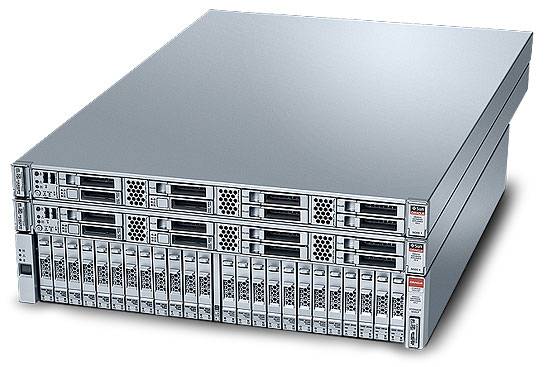
A few weeks ago, I posted an article about Oracle Database Appliance, focusing on ODA version 2.5.0.0.0. However, a new update of ODA, version 2.5.5.0.0, was released by Oracle on 5 March. This posting will focus on the new ODA release, which leads to a new hardware architecture.
So, what’s new with this new ODA version? According to the Release Notes, ODA now supports the new X3-2 architecture which allows additional hardware and storage capabilities.
Physical interconnection
Remember, the previous ODA version was shipped in the form of two 2U nodes. Each one was hosting multiple storage devices, and the nodes were already linked to each other. The front was composed of disks and the host was accessible from the rear. The cluster interconnect was included inside the rack. Users just had to plug in power as well as network and start the rack.
With the X3-2 architecture, ODA still comes in a 4U form, but each node is now independant and 1U sized. You can access the host by the front side, and each one is attached to a 2U storage shelf. This means that the user has to plug in network and power, but the interconnect and the storage also has to be configured by the user. The connection becomes a little bit more difficult!
Evolution perspective
When I reviewed ODA last week, I pointed out a major drawback: the hardware limitation. The new architecture now is evolutive: the storage shelf shipped with ODA can be upgraded with a second 2U storage shelf to get more storage capabilities. Other hardware components are still limited, but have been strongly upgraded with X3-2.
Hardware updates
The hardware is clearly more powerful. Here are the new hardware specifications of ODA X3-2 for each node – in comparison to the old configuration:
| Item | Old configuration | New configuration |
| CPU | 2 x X5675 | 2 x E5-2690 |
| Cores per CPU | 6 | 8 |
| Memory | 96 GB | 256 GB |
| SSD Disks for REDO Logs | 4 x 73 GB | 4 x 200 GB |
| SAS Disks for data files | 20 x 600 GB 15k rpm | 20 x 900 GB 10k rpm |
| SATA disks for operating system | 2 x 500 GB | 2 x 600 GB |
| Cluster interconnect | 2 x 1 GbE fibre | 2 x 10 GbE copper |
We can see that Oracle has put more powerful components on its ODA: more CPU, more Memory, and more disk space to host more databases.
To conclude
ODA virtualization support is still limited to the local storage of the host (2x600GB SATA disks) – no update on this point. This ODA version does not provide new features. In fact, this new release of ODA is “just a boost” of the old ODA architecture, with twice more CPU power and four times more storage capabilities.
![Thumbnail [60x60]](https://www.dbi-services.com/blog/wp-content/uploads/2022/12/oracle-square.png)
![Thumbnail [90x90]](https://www.dbi-services.com/blog/wp-content/uploads/2022/08/DWE_web-min-scaled.jpg)
![Thumbnail [90x90]](https://www.dbi-services.com/blog/wp-content/uploads/2024/04/SIT_web.png)
![Thumbnail [90x90]](https://www.dbi-services.com/blog/wp-content/uploads/2022/05/open-source-author.png)